





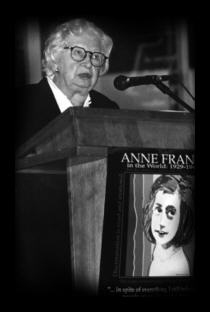
The
Story Of Miep Gies
www.miepgies.dk
| Miep Gies, the last
survivor among Anne Frank’s protectors and the woman who preserved the
diary that endures as a testament to the human spirit in the face of
unfathomable evil, died Monday night, the Anne Frank Museum in Amsterdam
said. She was 100. The British Broadcasting Corporation said Mrs. Gies suffered a fall late last month and died at a nursing home. January 11, 2010 |
Miep Gies, tiny, white-haired, gentle and courageous, is an unfamiliar name to most people, but without this remarkable woman, there would be no The Diary of Anne Frank. During the Nazi occupation of Holland the Austrian-born Dutch woman risked her life daily to hide Anne Frank and her family from the Nazis. For more than two years, Miep helped the Franks and four other people evade the Gestapo by bringing food, comfort and news of the world to them in a tiny hideout in the canal-side building that housed the family business.
It all ended on August 4, 1944, when their hiding place was betrayed and the family was arrested by the Nazis. A few hours later, wandering mournfully through the four small upstairs rooms, Miep discovered the plaid-cloth-covered diary kept by the young teenager.
By saving the diary from the debris left by the Nazis, Miep Gies made sure that Anne Frank’s name was known around the world - since its initial publication in 1947, The Diary of Anne Frank has sold more than 25 million copies in 54 languages. After the Bible, it is the most widely read book in the world - for many children, their first direct brush with the horrors of the Holocaust. Though Anne Frank never lived to see her 16th birthday, her innermost thoughts scribbled on scraps of paper still challenge us a full fifty years after her death ...
Ever since, Miep Gies has devoted her life to keeping the memory of her beloved friends alive. She is the only person mentioned in The Diary of Anne Frank who is still alive. Every year on August 4, she closes her curtains, ignores the doorbell, the telephone. Every year on August 4, Miep Gies grieves for her lost Jewish friends.
|
The young Miep |
|
Miep Gies was born in Vienna, Austria, in 1909 as Hermine Santrouschitz. She was five years old, when the First World War began and because of the serious food shortages during the war, she soon became undernourished and sick. In her book Anne Frank Remembered Miep recalled:
When I was ten years old, my parents had another child; another daughter. Now there was even less food for us all. My condition was worsening, and my parents were told that something had to be done or I would die.
As part of a relief program to help malnourished children she was sent by her hard-pressed parents to live with a middle-class Dutch foster family in Leiden in Holland:
The train was filled with many children like me, all with cards around their necks. Suddenly, the faces of my parents were no longer in sight anywhere and the train had begun to move. All the children were scared and apprehensive about what was to become of us. Some were crying. Most of us had never even been outside our streets, certainly never outside Vienna. I felt too weak to observe much, found the chugging motion of the train made me sleepy.
It was pitch-black, the middle of the night, when the train stopped. The sign beside the still-steaming train said Leiden:
Opposite the exhausted, sick children crowded a group of adults. Suddenly, those adults came at us in a swarm and began to fumble with our cards, reading off the names. We were helpless to resist the looming forms and fumbling hands. A man, not very big but very strong-looking, read my tag. Ja, he said firmly, and took my hand in his, helping me down from the chair. He led me away, I was not afraid and went with him willingly.
After several weeks, some of Miep's strength began to return.
Young Miep thrived in her new Dutch home, she growed to love her new family very much - five children, not much money, but great kindness. They taught her generosity. She never lived with her parents again. She was a good student, a reliable secretary, had a lively social life and was one of the first girls in Amsterdam to learn the Charleston.
In 1933 she took a job as an office assistant for Otto Frank, who had brought his Jewish family to Holland from Germany to escape the Nazis and reestablished his business in Amsterdam. Miep soon became good friends with the Frank family - Otto, his wife Edith, and their daughters, Margot and Anne.
The family's feelings of security collapsed, however, when in 1940, Adolf Hitler and his troops conquered Holland and the freedom of the Jews began to be severely restricted. Dictates on where Jews could shop, swim or go to school became a part of everyday life. As the brutality of the Nazis soon accelerated with murder, violence and terror, the seeds of their plan for the total extermination of the Jews dawned on Otto Frank in all its horror. He spent 1941-42 preparing and stocking an annex behind his business office at Prinsengracht 263 into a hiding place. The entrance to these rooms on the third and fourth floors was concealed by a moving bookcase which could be closed.


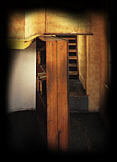
The closed bookcase, a model of the 3rd floor and the bookcase opened
He came to his loyal employee and friend Miep Gies with a question that would, in a split second, change her life forever. 'Miep,' he said, 'Are you willing to take on the responsibility of taking care of us if we go into hiding?' There was an immediate reply: 'Of course'. Of course, she said without asking for details. She agreed to help the Franks go into hiding in the secret annex despite threat of imprisonment, deportation or execution.
On her 13th birthday in 1942 Anne received as a gift from her parents, a diary. She immediately took to writing her intimate thoughts and musings. A few short weeks later, however, Margot received a notice from the Nazi SS to report for work detail at a labor camp. On July 5th, 1942, Anne and the Frank family moved to the 'Secret Annex' ..
Eight people eventually came to live in the secret annex. There were the four members of the Frank family, Otto Frank, Edith Frank, Margot and Anne, three from the Van Pels family, Herman and Auguste Van Pels and their son Peter, and an elderly man named Pfeffer, Miep's dentist.

Miep with Jan Gies
On July 16, 1941, Miep Santrouschitz married her boyfriend, Jan Gies, a social worker and member of the Dutch underground. Miep, Jan and three others risked their lives daily and acted as helpers for the people in the annex, and brought them food, supplies and news of the world outside the darkened windows.
Miep's friendship with Anne Frank was
especially strong. When she wrote the diary, Anne changed all the names of the
people in it, to protect them from Nazi retribution - except for Miep, whose
first name remained the same.
Miep brought her blank accounting
books so Anne could continue to scribble her thoughts after she filled the
checkered diary. Miep bought Anne her first pair of heels, secondhand red pumps,
which Anne teetered around on, biting on her lip, until she mastered them. Miep
even supplied some lavender peonies to Peter, who presented them to Anne as a
sign of his affection.
One night, Anne persuaded Miep to sleep over in the attic. Miep spent a suffocating, sleepless night on Anne's small, hard bed. She listened to the church clock across the garden chime at 15-minute intervals, listened to her own heart pound. She became aware of what it meant to be imprisoned in those small rooms and felt a taste of the helpless fear these people were forced to endure day and night.
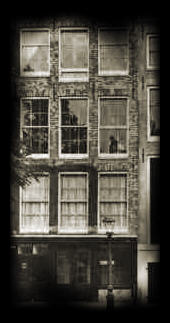
Prinsengracht 263
It all ended on August 4, 1944, when their hiding place was betrayed, probably by a Dutch woman Lena Hartog-van Bladeren. She was one of the cleaning women working in the office in front of the annex ...
The eight who lived in the annex were arrested by the Nazis and taken to Gestapo headquarters in Amsterdam, where the courageous Miep rushed to plead for their release - in vain. Two of the five who hid the group were sent to concentration camps. She herself was spared only because she was Austrian by birth, like the arresting officer.
As the Nazis searched the annex for valuables such as money, the briefcase in which Anne kept her writings was opened and the papers were scattered on the floor. Little did these men realize the eventual value of these materials.
Miep, who had supplied all of the notebooks for her young friend' s diary, was determined to retrieve them, despite the enormous threat from the Nazis. Using a spare set of keys, she visited the ransacked attic after the arrests, in defiance of Nazi orders. There, among the scattered papers on the floor, she found Anne's red-checked diary. Without opening it, she put it in an unlocked drawer of her desk, hoping to return it to Anne after the war.
 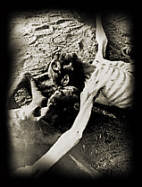 |
May, 1945. Photos taken at the Nazi KZ camp Bergen Belsen in Germany. Anne Frank ultimately ended up in this camp, after being evacuated from Auschwitz in October, 1944. Anne died here in April, 1945, just a few weeks before the camp was liberated by the British. She was 15 years old ... |
Otto Frank was the only survivor of the eight hidden Jews. Herman Van Pels was gassed upon the group's arrival at Auschwitz, September 6, 1944. His wife died between April 9 and May 8, 1945, in Theresienstadt KZ camp in Czechoslovakia. Their son Peter died on May 5, 1945, in Mauthausen KZ camp in Austria, after a forced march from Auschwitz. Fritz Pfeffer died December 20, 1944, at Neuengamme KZ camp. Anne's mother died January 6, 1945, at Auschwitz-Birkenau and her older sister, Margot, died at Bergen Belsen a few days before Anne.
Miep Gies hid the precious diary, keeping it for a year until official word arrived that Anne was dead. On that dreadful day, she reached into her desk drawer, removed the sheaves of paper, and handed them to a shattered Otto Frank.
'Here,' she told him, 'is your daughter Anne's legacy to you.'
Otto Frank decided to fulfill his daughter's wishes and arranged for the diary to be published in 1947. He lived with Miep and Jan Gies for seven years. He died in 1980.
Miep Gies didn't just help the eight people in the annex. She and Jan Gies hid a young Jewish student in their apartment. Miep never told Otto Frank about that.
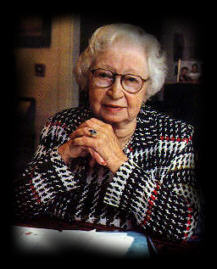
Miep Gies
Today, more than fifty years later, Miep Gies has spoken all over the United States and Europe on behalf of the Anne Frank Center, an international organization dedicated to tolerance. She lives alone in Amsterdam. Her husband, Jan, died in January 1993, 87 years old. He was honored after the war for his work in the resistance, receiving the Yad Vashem medal in Israel in 1977. In 1987, Jan and Miep Gies were presented with an award from the Jewish organization B'nai B'rith. In 1994 she received the Raoul Wallenberg Award for Bravery and in May that same year, she received The Righteous Amongst the Nations Award - along with Emilie Schindler.
Not long ago Miep Gies told about her friends hiding in the Annex:
I have no word to describe these people who were still always friendly and grateful. Yes, I do have a word, Heroes. True heroes they were. People sometimes call me a hero. I don't like it .. I myself, I'm just a very common person. I simply had no choice. I could not save Anne's life. However, I did save her diary and by that I could help her most important dreams to come true. She tells us that she wants to live on after her death. Now, her diary makes her really living on in a most powerful way. And that helps me in those many hours of deep grief.
It has happened that people walk up to me and ask me what I would answer to those who deny that the Holocaust even took place. My response is that on August 4, 1944, at 9'oclock in the morning I did meet a healthy and strong 15-year old girl, Anne Frank. The next thing I saw was her name in a German list of people on a cattle train to Auschwitz. So please, tell me where Anne Frank lives at this moment if the Holocaust did not take place, because Anne Frank would still be with us today ..
Anne Frank would have been nearly 73 years old now. What would she have become? In an interview with Steve North, Jerusalem Post, Miep Gies has no doubt:
|
'Oh, a writer, of course. A good, famous writer ... and a grandmother. She would have been a grandmother.' |
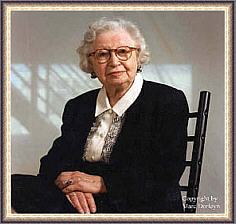
Read The Guestbook! | Sign The Guestbook!
sources:
The Guardian of Anne Frank's Spirit 50 years later by Laura Blumenfeld, St. Louis Post-Dispatch
Anne Frank Remembered by Miep Gies with Alison Leslie Gold (Simon & Schuster/Touchstone)
The Woman who hid The Frank Family by Susan Stamberg, Brian Naylor, Morning Edition
The Anne Frank Story - The Last Link by Anemona Hartocollis, Newsday
When Conscience calls by Steve North, Jerusalem Post
Nicole Casperi's Anne Frank Site
Photo
- The Orion/Eddie Maravilla
www.auschwitz.dk www.oskarschindler.com www.emilieschindler.com www.shoah.dk
© 2016-2018
Louis Bülow Privacy
All Rights Reserved.